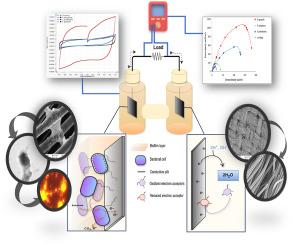Influence of different exo-electrogens as biocatalyst on the bio-electrochemical behavior of H-type microbial fuel cell
IF 7.9
2区 工程技术
Q1 CHEMISTRY, PHYSICAL
引用次数: 0
Abstract
Being the source of electrons, microbes are the key players in MFCs; thus, it is imperative to investigate their effect on the bio-electrochemical processes therein so as to develop efficient systems with high power outputs. This study investigates the influence of four different anodic microbial cultures, Pseudomonas gessardii PG, Pseudomonas aeruginosa PA, Shewanella putrefaciens SP, and cowdung CD enriched inoculum, on the electrochemical performance of H-type MFC. Out of the four biocatalysts studied, most efficient electron transfer was observed in the case of PG, as indicated by the highest anodic peak current (0.717 mA) obtained by cyclic voltammograms and minimum internal resistance. Also, PG showed highest open circuit potential (OCP) and power density 504 mV and 1.05 W m−2 respectively, followed by SP (280 mV, 0.56 W m−2), CD (227 mV, 0.192 W m−2) and PA (190 mV, 0.168 W m−2). High catabolic potential, active biofilm formation, and low corrosion rate were also identified as important reasons for better electrochemical performance observed in PG. Furthermore, SEM analysis of anodic biofilms revealed clusters of microbial cells attached to carbon cloth fibers (anode), while HR-TEM and epifluorescence images indicate the presence of elongated nanowires-like extensions in the cultures, which are supposedly involved in intercellular transport of electrons.

不同外源电作为生物催化剂对h型微生物燃料电池生物电化学行为的影响
作为电子的来源,微生物是mfc的关键参与者;因此,有必要研究它们对其中的生物电化学过程的影响,从而开发出高功率输出的高效系统。研究了绿脓假单胞菌PG、铜绿假单胞菌PA、腐坏希瓦氏菌SP和牛粪CD富集菌4种不同阳极微生物培养物对h型MFC电化学性能的影响。在所研究的四种生物催化剂中,PG的电子转移效率最高,通过循环伏安图获得的阳极峰值电流最高(0.717 mA),内阻最小。此外,PG的开路电位和功率密度最高,分别为504 mV和1.05 W m−2,其次是SP (280 mV, 0.56 W m−2)、CD (227 mV, 0.192 W m−2)和PA (190 mV, 0.168 W m−2)。高分解代谢电位、活性生物膜形成和低腐蚀速率也被认为是PG中观察到的更好的电化学性能的重要原因。此外,阳极生物膜的SEM分析显示,微生物细胞簇附着在碳布纤维(阳极)上,而HR-TEM和荧光图像显示,培养物中存在细长的纳米线样延伸物,这可能与细胞间电子传递有关。
本文章由计算机程序翻译,如有差异,请以英文原文为准。
求助全文
约1分钟内获得全文
求助全文
来源期刊

Journal of Power Sources
工程技术-电化学
CiteScore
16.40
自引率
6.50%
发文量
1249
审稿时长
36 days
期刊介绍:
The Journal of Power Sources is a publication catering to researchers and technologists interested in various aspects of the science, technology, and applications of electrochemical power sources. It covers original research and reviews on primary and secondary batteries, fuel cells, supercapacitors, and photo-electrochemical cells.
Topics considered include the research, development and applications of nanomaterials and novel componentry for these devices. Examples of applications of these electrochemical power sources include:
• Portable electronics
• Electric and Hybrid Electric Vehicles
• Uninterruptible Power Supply (UPS) systems
• Storage of renewable energy
• Satellites and deep space probes
• Boats and ships, drones and aircrafts
• Wearable energy storage systems
 求助内容:
求助内容: 应助结果提醒方式:
应助结果提醒方式:


